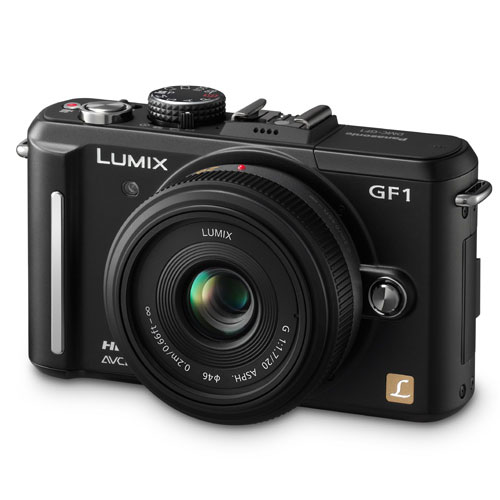
‘Tis the season of digital camera introductions, and Panasonic doesn’t want to be left out of the loop: today the company introduced its new Lumix DMC-GF1 digital camera, packing the capability to record high-definition video into a Micro Four Thirds System. Micro Four Thirds cameras support interchangeable lenses—just like DSLRs—but don’t use the same prism-and-mirror setup, making it possible to pack the camera into a much smaller body—the result is a camera with DSLR-like quality that isn’t a pain to carry around.
“The new Lumix GF1 continues the evolution and is the perfect addition to our Lumix G Series, as its sophisticated, small body makes it easier and more convenient to carry,” said Panasonic senior product manager David Briganti, in a statement. “The GF1 is ideal for point-and-shoot consumers looking to step-up to DSLR-quality or for current DSLR users who want greater convenience without compromising performance quality or creative flexibility.”
The GF1 offers a 12-megapixel resolution with a 3-inch LCD viewfinder and an integrated flash; the camera stores images to SD/SDHC cards, and features optical image stabilization and a dust cleaning system to keep the sensor clear. The camera offers a new “My Color” mode with a selection of preset effects (like Retro, Monochrome, and “Expressive”…whatever that means) so users can quickly shift between color, saturation, and brightness levels, and a Live View function enables users to see how the My Color settings will look before they take a shot. The camera also sports nine Film modes, and a custom function lets users store their favorite settings for re-use. For point-and-shoot users, the camera offers a “peripheral defocus” feature that keeps the foreground in focus but blurs out the background—or vice versa—helping beginning photographers achieve greater depth of field.
The GF1 can also capture 1,280 by 720 pixel high-definition video in AVCHD Lite and Motion JPEG formats; lower resolution video capture is also available. The GF1 engages its optical image stabilization when shooting video to keep shakes to a minimum, and face detection and intelligent exposure control help keep videos clear.
The GF1 will be available in two separate kits; one includes the just-announced LumixG 20mm/ƒ1.7 ASPH compact “pancake” lens, while the other sports a Lumix G Vario 14–45mm/ƒ3.5–5.6 ASPH/MEGA O.I.S. lens—which isn’t so compact. Both kits will have a suggested retail price of $899.95.


